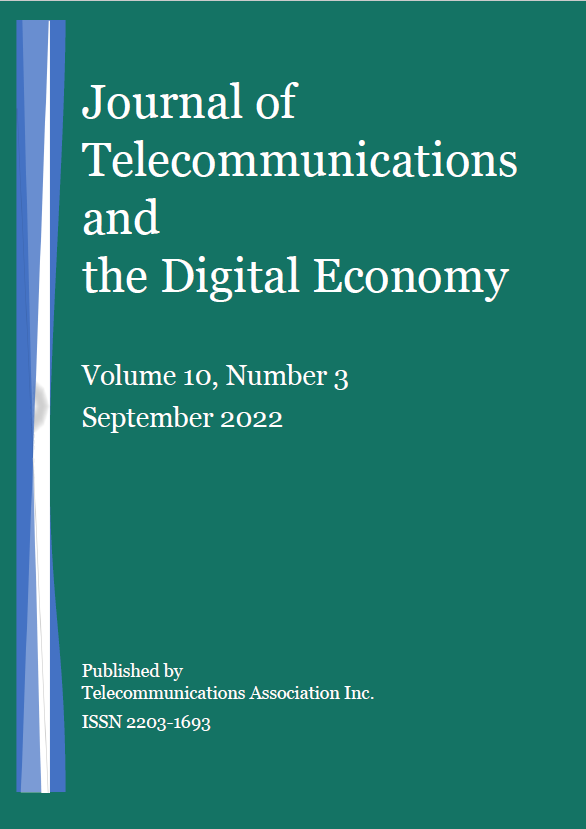Latency Analysis for Mobile Cellular Network uRLLC Services
Main Article Content
Keywords
Ultra-reliable Low Latency Communications, Multi-access Edge Computing, End-to-End Latency, User Plane, Control Plane
Abstract
The fifth generation (5G) mobile network technologies include ultra-Reliable Low Latency Communications (uRLLC) capability. To fully exploit uRLLC, distributed Multi- access Edge Computing (MEC) is being developed and introduced at the network edge with an architecture that supports applications and services. Some of the MEC applications will benefit from uRLLC, including virtual reality, augmented reality, education, health, online gaming, automatic manufacturing and Vehicle-to-everything. However, unique challenges and opportunities exist for 5G cellular networks and MEC due to a range of factors, including end-user device mobility and the implementation of the network Control Plane (CP) and User Plane (UP). In this regard, there is a need to optimize protocols and network architecture. This paper investigates latency and related network elements in the next generation mobile cellular network. We also analyze the 5G network latency in the CP and UP. Finally, the paper identifies protocol optimization considerations for MEC integration with 5G to achieve low end-to-end latency.
References
E.Group. (2018). 5G; NG-RAN; architecture description. ETSI, Technical Report.
E.Group. (2019). 5G; NR; overall description; stage-2. ETSI, Technical Report.
Evangelista, J. V., Kaddoum, G., & Sattar, Z. (2021). Reliability and User-Plane Latency Analysis of mmWave Massive MIMO for Grant-Free URLLC Applications. arXiv preprint arXiv:2107.08151.
Fan, X., & Huo, Y. (2021). An Overview of Low latency for Wireless Communications: an Evolutionary Perspective. arXiv preprint arXiv:2107.03484.
G.Group.A. (2021). Service requirements for the 5G system. ETSI, Technical Report.
G.Group.A. (2020). System architecture for the 5G system. ETSI, Technical Report.
G.Group.B. (2020). Study on scenarios and requirements for next generation access technologies. ETSI, Technical Report.
G.Group.B. (2021). Procedures for the 5G system. ETSI, Technical Report.
Gaur, A. S. (2018). Containerized IoT Solution for Efficient Mobile Vertical Handover, Doctoral dissertation, Carleton University.
Gimenez, L. C., Michaelsen, P. H., Pedersen, K. I., Kolding, T. E., & Nguyen, H. C. (2017, June). Towards zero data interruption time with enhanced synchronous handover. In 2017 IEEE 85th Vehicular Technology Conference (VTC Spring) (1–6).
Guimaraes, R. S., Martínez, V. M., Mello, R. C., Mafioletti, D. R., Martinello, M., & Ribeiro, M. R. (2020, June). An SDN-NFV Orchestration for Reliable and Low Latency Mobility in Off-the-Shelf WiFi. In ICC 2020-2020 IEEE International Conference on Communications (ICC) (1–6).
Hattachi, R. E., & Erfanian, J. (2015). 5G white paper. NGMN White Paper. Available at https://www.ngmn.org/wp-content/uploads/NGMN_5G_White_Paper_V1_0.pdf
Huedo, E., Montero, R. S., Moreno-Vozmediano, R., Vázquez, C., Holer, V., & Llorente, I. M. (2021). Opportunistic deployment of distributed edge clouds for latency-critical applications. Journal of Grid Computing, 19(1), 1–16.
Jain, A., Lopez-Aguilera, E., & Demirkol, I. (2018, September). Improved handover signaling for 5G networks. In 2018 IEEE 29th Annual International Symposium on Personal, Indoor and Mobile Radio Communications (PIMRC) (164–170).
Jin, R., Zhong, X., & Zhou, S. (2016, December). The access procedure design for low latency in 5G cellular network. In 2016 IEEE Globecom Workshops (GC Wkshps) (1–6).
Kasenides, N., & Paspallis, N. (2020, September). Multiplayer game backends: A Comparison of commodity cloud-based approaches. In European Conference on Service-Oriented and Cloud Computing (41–55). Springer, Cham.
Khaturia, M., Manjeshwar, A. N., Jha, P., & Karandikar, A. (2021, March). 5G-Serv: Decoupling User Control and Network Control in the 3GPP 5G Network. In 2021 24th Conference on Innovation in Clouds, Internet and Networks and Workshops (ICIN) (75–79). IEEE.
Kurian, A. (2018). Latency analysis and reduction in a 4G network. Technical University of Delft, Master thesis. Available at http://resolver.tudelft.nl/uuid:e1badd8d-a384-49a1-b958-a0c1e499c539
Li, Z., Wang, X., & Zhang, T. (2020). 5G+: How 5G change the society. Springer Nature.
Martini, B., Paganelli, F., Cappanera, P., Turchi, S., & Castoldi, P. (2015, April). Latency-aware composition of virtual functions in 5G. In Proceedings of the 2015 1st IEEE conference on network softwarization (NetSoft) (1–6).
Mohammadkhan, A., Ramakrishnan, K. K., & Jain, V. A. (2020). CleanG—Improving the Architecture and Protocols for Future Cellular Networks With NFV. IEEE/ACM Transactions on Networking, 28(6), 2559–2572.
Mohammadkhan, A., Ramakrishnan, K. K., Rajan, A. S., & Maciocco, C. (2016, December). Cleang: A clean-slate EPC architecture and control plane protocol for next generation cellular networks. In Proceedings of the 2016 ACM Workshop on Cloud-Assisted Networking (31–36).
Parvez, I., Rahmati, A., Guvenc, I., Sarwat, A. I., & Dai, H. (2018). A survey on low latency towards 5G: RAN, core network and caching solutions. IEEE Communications Surveys & Tutorials, 20(4), 3098–3130.
Peltonen, A., Sasse, R., & Basin, D. (2021, June). A comprehensive formal analysis of 5G handover. In Proceedings of the 14th ACM Conference on Security and Privacy in Wireless and Mobile Networks (1–12).
Peñaherrera-Pulla, O. S., Baena, C., Fortes, S., Baena, E., & Barco, R. (2021). Measuring key quality indicators in cloud gaming: Framework and assessment over wireless networks. Sensors, 21(4), 1387.
Premsankar, G., Di Francesco, M., & Taleb, T. (2018). Edge computing for the Internet of Things: A case study. IEEE Internet of Things Journal, 5(2), 1275–1284.
Shukla, S., Hassan, M., Tran, D. C., Akbar, R., Paputungan, I. V., & Khan, M. K. (2021). Improving latency in Internet-of-Things and cloud computing for real-time data transmission: a systematic literature review (SLR). Cluster Computing, 1–24.
Sreenibha Reddy, B., & Zaahid, M. (2018). Performance Metrics Analysis of Gaming Anywhere with GPU accelerated NVIDIA CUDA. Blekinge Institute of Technology, Master’s thesis. Available at https://www.diva-portal.org/smash/record.jsf?pid=diva2%3A1261108&dswid=-6847
Tan, Z., Li, Y., Li, Q., Zhang, Z., Li, Z., & Lu, S. (2018). Supporting mobile VR in LTE networks: How close are we? Proceedings of the ACM on Measurement and Analysis of Computing Systems, 2(1), 1–31.
Tomaszewski, L., Kukliński, S., & Kołakowski, R. (2020, June). A new approach to 5G and MEC integration. In IFIP International Conference on Artificial Intelligence Applications and Innovations (15–24). Springer, Cham.
Zhou, P., Finley, B., Li, X., Tarkoma, S., Kangasharju, J., Ammar, M., & Hui, P. (2021). 5G MEC computation handoff for mobile augmented reality. arXiv preprint arXiv:2101.00256.






